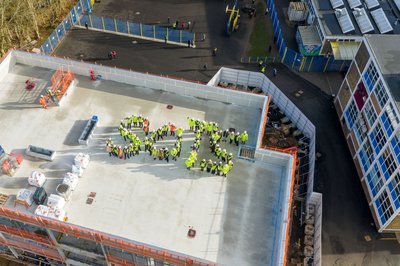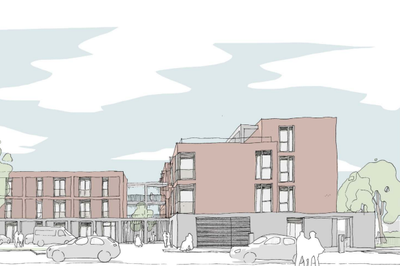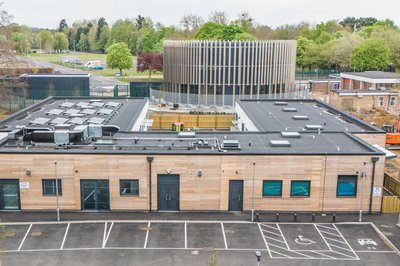Kenilworth Secondary School & Sixth Form
The once vacant land inhabited by greenery and ponds has now been transformed into one of the largest secondary schools in the UK, with the ability to accommodate up to 2,200 students. The Kenilworth Secondary School and Sixth Form combines three former separate schools within the local community.
Key Stats
- One of the largest schools in the UK
- Delivered on time and on budget
- One new school which replaces three schools within the community
- 2,200 pupil places
- Electric charging points available for staff
At a Glance
Budget
£45.6m
Completion
May 2023
Location
Kenilworth, Birmingham
Framework
PAGABO Framework
Sector
Education, Secondary
Social value
£32.2 million
Sustainability
97% Waste Diverted from Landfill
About the Kenilworth Secondary and Sixth Form School
Kenilworth Secondary School and Sixth Form (KSSF) has been recognised as a world class educational hub in the community. One which invites inclusion and the promise of delivering exceptional education to secondary school students.
The previous split sites and age of the properties meant that the estate did not support the school’s ambitions to improve efficiency, reduce costs and carbon emissions. A key issue was movement of staff between sites during the day. Therefore, to continue to improve their service and keep their promise, a new school has been delivered covering over 36 acres of land. The project included main school buildings, outdoor play areas, sports facilities, car parking and a biodiversity zone.

Journey towards educational excellence
KSSF strive to enable students to be the very best they can be. In the quest of achieving this aspiration the new school has been carefully designed. Through several public consultation sessions and input from various stakeholders, the school embodies the vision of the community.
The architecture of the building sees five finger wings all connected by one spine, giving a spacious and open feel to the school. Internally, each wing of the school is a specific subject and can be distinguished by a unique colour.
The landscaping of the school has been designed to enhance the student and teacher experience. In between each wing of the building, a mini plant garden has been built. These plant gardens encourage the student’s to be creative whilst offering an appropriate change in environment to the building. The outdoor space will support student’s mental health and wellbeing whilst being sympathetic to the environment. The plant gardens are self-maintained whereby rainwater collected on the roof waters the plant garden.
Building a sustainable school
A key requirement for the new school was the need to become more sustainable and reduce carbon emissions. Mechanical Ventilation Heat Recovery units (MVHR) had been set up in most classrooms in the building. MVHR units provide fresh filtered air into the building whilst retaining most of the energy that has already been used in heating the building.
Along with the units, there are also radiant panels which circulate hot or cold water through concealed copper tubing on the back of the panels. This provides sustainable heating and cooling with minimal air ventilation requirements.
Substantial Cost and Carbon Savings made
Upon the previous site, there was existing farm structures and a substation, all of which, had been enclosed by the mass amount of greenery. The topography of the previous site however presented the biggest challenge for the team.
The ground was uneven with a slight decline falling towards the centre of the site from the north-east boundary and from the south-western boundary. As a result, the site required a creative landscaping solution to remodel the topography and overcome those significant falls. The cut and fill exercise would become crucial to ensure the site was level throughout. What the project team did was drop the site level by 5.5 metres in one corner and raise the site by 10 metres in the other corner without the need for carting away any soil. This ensured the school remained on a flat surface and enabled the project team to construct the new school on a suitable blank canvas. The fields directly behind the school continue to have a natural decline as you walk towards the sports pitches.
The cut and fill exercise produced cost and carbon savings as all the soil was completely recycled into the landscape design.
Tree Planting with the Woodlands Trust
Over the past two years the school approached The Woodlands Trust and successfully bid for some saplings to help improve the landscape and to help offset pollution, HS2 and to make the new school site more 'green' both literally and metaphorically. The Woodlands Trust is a partner that is associated with the Queens Green Canopy initiative.
In our last bid we received 315 saplings ranging from cherry trees, dog roses, silver birch, and oak trees. The project team managed to distribute these trees to all parts of the school community and these saplings are thriving in homes around Kenilworth and Warwickshire, some trees are being looked after by staff.
In November 2022 we received a further 420 saplings: rowans, dogwood, silver birch, hawthorn, blackthorn, hazel, cherry, and crab apple. These trees were nurtured by the whole school community and were transported to the new school site to help make the site eco-friendlier as we approach the opening of the new site.
Time capsule in memory of COVID-19
The project commenced during a difficult and tragic period worldwide, the COVID-19 pandemic. Students and the head of Kenilworth School handed over a time capsule to our site team for burial. Headteacher Hayden Abbott and members of the student council presented the capsule to some of the construction team for burial in the school courtyard later in the year. Students spent weeks gathering objects which reflect modern day life to put in the narrow capsule, including artwork, information on GCSEs and A levels and lateral flow tests as a reminder of the Covid-19 pandemic.
The school looks amazing, bright with lots of natural light and sustainable features throughout”
Hayden Abbott, Headteacher
Gallery
Related News
NEWS

Morgan Sindall Marks Steel Signing Milestone at Selly Oak SEN School
Morgan Sindall Construction has marked a significant milestone in the delivery of Selly Oak SEN School with a steel signing ceremony, celebrating the completion of the building's structural frame.
NEWS

Morgan Sindall celebrates topping out at Hexham Road care and residential scheme
Morgan Sindall Construction’s Thames Valley business has marked a major milestone in the development of the £21.9 million Hexham Road residential and adult care facility, celebrating the project’s topping …
NEWS

Stellar New Nursery at UKAEA’s Culham Science Campus
Morgan Sindall Construction’s Thames Valley team has successfully handed over Culham Science Centre Nursery & Preschool, a purpose-built early years facility located on the site of the UK …















